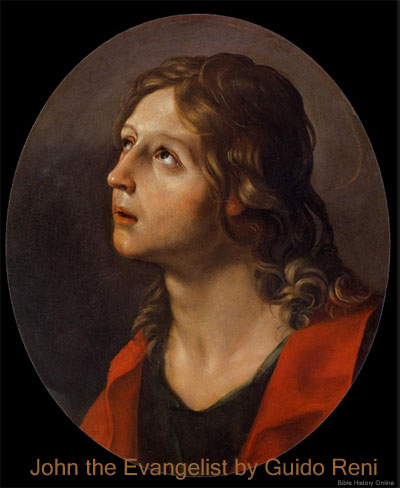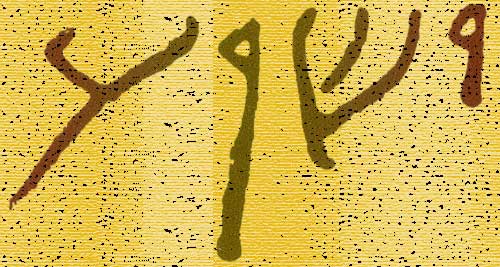Re 5:1-14. THE BOOK WITH SEVEN SEALS: NONE WORTHY TO OPEN IT BUT THE LAMB: HE TAKES IT AMIDST THE PRAISES OF THE REDEEMED, AND OF THE WHOLE HEAVENLY HOST.
1. in, &c.--Greek, "(lying) upon the right hand."
His right hand was open and on it lay the book. On God's part there was
no withholding of His future purposes as contained in the book: the
only obstacle to unsealing it is stated in
Re 5:3
[ALFORD].
book--rather, as accords with the ancient form of books, and
with the writing on the backside, "a roll." The writing on
the back implies fulness and completeness, so that nothing more
needs to be added
(Re 22:18).
The roll, or book, appears from the context to be "the title-deed of
man's inheritance" [DE BURGH] redeemed by Christ, and contains the successive
steps by which He shall recover it from its usurper and obtain actual
possession of the kingdom already "purchased" for Himself and His elect
saints. However, no portion of the roll is said to be unfolded
and read; but simply the seals are successively
opened, giving final access to its contents being read as a
perfect whole, which shall not be until the events symbolized by the
seals shall have been past, when
Eph 3:10
shall receive its complete accomplishment, and the Lamb shall
reveal God's providential plans in redemption in all their manifold
beauties. Thus the opening of the seals will mean the successive steps
by which God in Christ clears the way for the final opening and reading
of the book at the visible setting up of the kingdom of Christ.
Compare, at the grand consummation,
Re 20:12,
"Another book was opened . . . the book of life";
Re 22:19.
None is worthy to do so save the Lamb, for He alone as such has
redeemed man's forfeited inheritance, of which the book is the
title-deed. The question
(Re 5:2)
is not (as commonly supposed), Who should reveal the destinies of the
Church (for this any inspired prophet would be competent to do)? but,
Who has the WORTH to give man a new title to
his lost inheritance? [DE BURGH].
sealed . . . seven seals--Greek, "sealed up,"
or "firmly sealed." The number seven (divided into four, the
world-wide number, and three, the divine) abounds in Revelation and
expresses completeness. Thus, the seven seals,
representing all power given to the Lamb; the seven trumpets, by
which the world kingdoms are shaken and overthrown, and the Lamb's
kingdom ushered in; and the seven vials, by which the beast's
kingdom is destroyed.
JFB.
The Book of Revelation
Revelation 1:9-11 - I John, who also am your brother, and companion in tribulation, and in the kingdom and patience of Jesus Christ, was in the isle that is called Patmos, for the word of God, and for the testimony of Jesus Christ. I was in the Spirit on the Lord's day, and heard behind me a great voice, as of a trumpet, Saying, I am Alpha and Omega, the first and the last: and, What thou seest, write in a book, and send [it] unto the seven churches which are in Asia; unto Ephesus, and unto Smyrna, and unto Pergamos, and unto Thyatira, and unto Sardis, and unto Philadelphia, and unto Laodicea.
Revelation 19:11-16 - And I saw heaven opened, and behold a white horse; and he that sat upon him [was] called Faithful and True, and in righteousness he doth judge and make war. His eyes [were] as a flame of fire, and on his head [were] many crowns; and he had a name written, that no man knew, but he himself. And he [was] clothed with a vesture dipped in blood: and his name is called The Word of God. And the armies [which were] in heaven followed him upon white horses, clothed in fine linen, white and clean. And out of his mouth goeth a sharp sword, that with it he should smite the nations: and he shall rule them with a rod of iron: and he treadeth the winepress of the fierceness and wrath of Almighty God. And he hath on [his] vesture and on his thigh a name written, KING OF KINGS, AND LORD OF LORDS.
Revelation 22:18-20 For I testify unto every man that heareth the words of the prophecy of this book, If any man shall add unto these things, God shall add unto him the plagues that are written in this book: And if any man shall take away from the words of the book of this prophecy, God shall take away his part out of the book of life, and out of the holy city, and [from] the things which are written in this book. He which testifieth these things saith, Surely I come quickly. Amen. Even so, come, Lord Jesus.
Revelation in The New Testament - A Brief Overview

Painting of St. John the Evangelist by Reni - 1620
Introduction to The Book of Revelation
Brief Summary. John describes the seven churches in Asia, he records the visions that he received, and in the prophecy Jesus returns as the kinsman redeemer to claim this world as His inheritance. The final battle unfolds in a 7 year period through a series of seal, trumpet, and bowl judgements, He casts the antichrist and false prophet into the lake of fire and sets up the New Jerusalem, the new heaven and new earth for the redeemed. The book of Revelation is in harmony with the prophecies in the Old Testament especially the ones written by Ezekiel, Daniel and Zechariah.
Summary of The Book of Revelation
Author. John the apostle names himself as the one who wrote down what the Lord said through the angel. The earliest writers in the church like Justin Martyr, Irenaeus, Hippolytus, Tertullian, Clement of Alexandria and the Muritorian all credit John the apostle as author of the book of Revelation.
Date. John indicates that he was on the Island of Patmos when he received the prophecy (Revelation 1:9). According to tradition John wrote during the reign of the Emperor Domitian which would have been around 95 AD. Tradition also states that John was released the next year and was allowed to return to Ephesus. Domitian was perhaps the cruelest Emperor toward the Christians, demanding that he was to worshipped as deity, or be put to death.
Audience. John said that the prophecy was directed to the seven churches in Asia (Revelation 1:4).
Outline of the Book of Revelation
Description and Fate of False Teachers - 1:1-16
Encouragement to Believers in Christ - 1:17-25

The Name Jesus In Ancient Hebrew Text
"Yeshua" in First Century Hebrew Text. This is how the name "Jesus"
would have been written in ancient Hebrew documents. The four letters or
consonants from right to left are Yod, Shin, Vav, Ayin (Y, SH, OO, A).
Jesus is the Greek name for the Hebrew name Joshua or Y'shua which means
"The LORD or Yahweh is Salvation".
The Book of Revelation Resources
Map of the Roman Empire (14 A.D.) - This map reveals the Roman Empire during the time shortly after the birth of Jesus, in 14 AD at the time of the death of Augustus. The order which prevailed in this extensive empire, the good military roads, and the use of Koine Greek as the general language of culture throughout the area were among the factors which multiplied the rapid spread of the Gospel of Jesus Christ. (Color Map)
Map of Paul's First Missionary Journey (48 A.D.) - This map reveals the areas in Asia Minor where Paul visited in his first missionary journey. Around 48 AD, in the springtime, Paul and his companions Barnabas and Mark were sent on a mission from the church in Antioch. This would be the first of Paul's Missionary Journey's. (Color Map)
Map of Paul's Second Missionary Journey (51 A.D.) - This map reveals the areas in Asia and Greece where Paul visited in his second missionary journey. Paul re-visits a couple cities in Asia, one of which was Lystra where he was stoned and left for dead a few years earlier. He later has a vision that leads him over to Greece and Paul and his companions travel and minister in various cities in Greece (Philippi, Thessalonica, Berea, Athens and Corinth. Later Paul returns to Ephesus and finally to Caesarea and Antioch. (Color Map)
Map of Paul's Third Missionary Journey (54 A.D.) - This map reveals the areas in Asia and Greece where Paul visited in his third missionary journey. On Paul's third missionary journey he returned to the cities he had first visited on his first missionary journey. During this time he decided to remain in Ephesus for about 3 years, and this city was the main focus of his activities and an important Christian community (Acts 19). (Color Map)
Map of the New Testament World - This map reveals the "Nations" within the ancient world during the first century A.D., the time of the New Testament. The map includes the areas of Israel, Asia, Greece, and Italy. (Color Map)
Map of New Testament Greece This map reveals the cities within Greece in the ancient world during the first century A.D.,The map includes the principal cities of Greece like: Athens, Corinth, and Thessalonica, and provinces like Macedonia and Achaia. (Color Map)
Map of New Testament Asia - This map shows the cities within
Asia Minor during the first century A.D., the time of the New
Testament. The map includes the principal cities of Asia
including Tarsus, Ephesus, and Colossae, and provinces like
Galatia and Pamphilia. (Color Map)